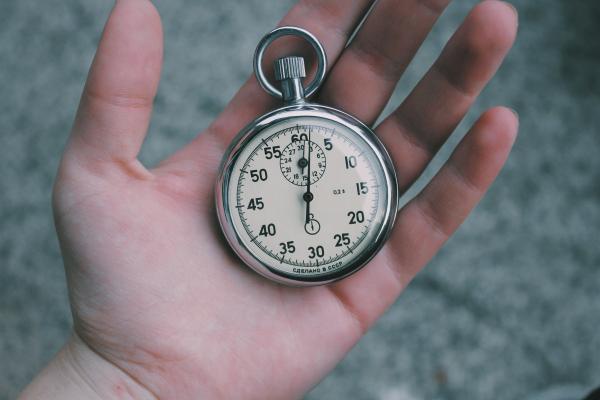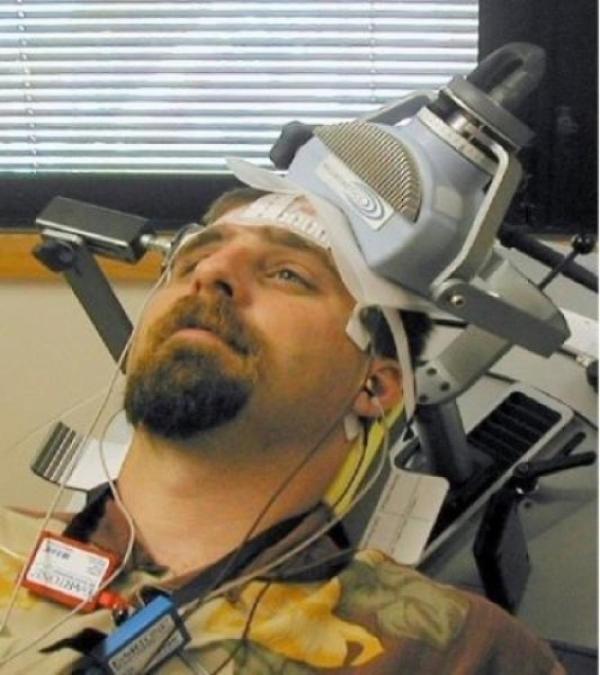To Boost Learning, Timing May Be Everything
New Strategy Could Enhance Benefits of Therapeutic Brain Stimulation

Timing electrical brain stimulation to coincide with specific periods of neuronal firing could increase its effects, according to new IRP research.
Electricity can do crazy things to the brain. While it can’t bring back the dead à la Frankenstein or give you new memories like in Total Recall, many scientists believe electrical stimulation could one day help patients with movement or memory problems regain those capabilities. New IRP research bolsters this idea by showing that a brain stimulation technology called transcranial magnetic stimulation (TMS) significantly boosts motor skill learning when precisely administered during specific periods of brain activity.1
Neurons in the brain and throughout the body transmit information using electricity. Groups of neurons in the brain continuously cycle in unison between periods of heightened and suppressed electrical activity that neuroscientists call ‘oscillations’ or ‘rhythms.’ During deep sleep, for example, neurons in the brain’s cortex switch between electrical highs and lows roughly one to four times per second, a phenomenon called the ‘delta rhythm.’
IRP senior investigator Leonardo Cohen, M.D., is more interested in what the brain is doing when it is awake, particularly a cycling of neuronal activity called the ‘mu rhythm’ that can be seen in brain regions responsible for sensory perception and movement, like the primary motor cortex. What’s more, he believes that studying this neuronal rhythm can potentially boost the effects of brain stimulation approaches like TMS, which uses magnetic fields to generate electrical currents in the brain.
“TMS has been around for about 30 years now,” Dr. Cohen says. “One of the problems that became evident over the years is that the magnitude of the effects induced by TMS is variable. One way to think about why this is the case is because TMS is being delivered irrespective of the facilitatory or inhibitory phases of neuronal oscillations. Perhaps, if one were to deliver stimulation only at a consistent part of the cycle, then the effects could potentially be more consistent and reproducible.”

Image credit: Mark George, M.D., Medical University of South Carolina
A man receives TMS as part of a research study.
To test this idea, researchers led by Dr. Cohen and Sara Hussain, Ph.D., a former postdoctoral fellow in his lab who is now an assistant professor at the University of Texas at Austin, explored whether delivering TMS during specific phases of neuronal oscillations could enhance learning. Dr. Cohen’s team had 51 healthy, right-handed individuals practice a motor task that required them to repeatedly type out a specific five-digit numeric sequence as quickly and accurately as possible with their left hands.
Immediately after finishing their practice sessions, the participants were split into three groups. One group received TMS delivered to the primary motor cortex that was precisely timed to stimulate their brains only during the ‘trough’ phases of the mu rhythm, while a second group received TMS stimulation to the same brain region only during the ‘peak’ phases of the mu rhythm. Counterintuitively, neurons in the primary motor cortex are most active during the trough phases of the mu rhythm and least active during the peak phases. Unbeknownst to the remaining participants, the third group received ‘sham’ TMS that felt and sounded like the real thing but did not actually stimulate their brains. The next day, all participants returned to do the same typing task again.
As expected, all participants got better at the task as they practiced on the first day of the experiment. Moreover, the participants performed the task better on the second day than at the end of the first day, but the participants who had received TMS stimulation only during trough phases of the brain’s mu rhythm improved nearly 50 percent more than the other two groups, which showed similar performance gains to each other.
“TMS stimulation for therapeutic purposes is usually given regardless of phase,” Dr. Cohen explains. “When we look at our results, we see that TMS during trough phases increases performance by nearly 50 percent, so in reality what researchers are doing right now is a mix of that 50 percent boost when TMS is given during trough phases and the zero percent improvement when TMS is given during peak phases. The mix of those makes the overall size of the effect potentially much smaller.”

Dr. Leonardo Cohen, the new study’s senior author
The researchers also used electroencephalography (EEG) to measure a phenomenon called ‘whole-brain power responses’ elicited by the TMS. These power responses are thought to reflect how much neurons are firing throughout the brain, although the exact nature of the relationship is unclear. Nevertheless, Dr. Cohen’s team found that TMS boosted whole-brain power responses in all participants, but the power responses were greater when TMS was given during trough phases of the mu rhythm than when it was given during the rhythm’s peak phases. This suggests that the TMS was causing a larger change in brain activity when applied during trough phases than during peak phases.
Of course, the motivation behind these kinds of studies is not to help people learn to type random sequences more quickly. Rather, Dr. Cohen hopes to learn about how TMS can be more effectively used to help patients with neurological problems due to strokes or dementia regain their ability to perform complex movements like walking or grasping objects. Researchers in his lab are currently working to determine if TMS can assist learning in those sorts of patients, as well as in older adults who are cognitively healthy.
“One could conceivably customize or develop more effective neurorehabilitative tools by choosing to neuromodulate learning in these tasks during these precise windows of opportunity,” Dr. Cohen says. “This sort of phase-dependent TMS could provide a better tool to treat memory disorders than what we have available so far.”
Subscribe to our weekly newsletter to stay up-to-date on the latest breakthroughs in the NIH Intramural Research Program.
Related Blog Posts
This page was last updated on Wednesday, May 24, 2023
